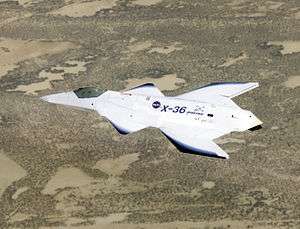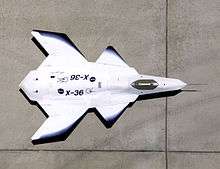McDonnell Douglas X-36
The McDonnell Douglas (later Boeing) X-36 Tailless Fighter Agility Research Aircraft was an American stealthy subscale prototype jet designed to fly without the traditional tail assembly found on most aircraft. This configuration was designed to reduce weight, drag and radar cross section, and increase range, maneuverability and survivability.[2]
| X-36 | |
|---|---|
 | |
| X-36 in flight | |
| Role | Research aircraft |
| Manufacturer | McDonnell Douglas/Boeing |
| First flight | 17 May 1997 |
| Status | Retired |
| Number built | 2[1] |
Design and development

The X-36 was built to 28% scale of a possible fighter aircraft, and was controlled by a pilot in a ground-based virtual cockpit with a view provided by a video camera mounted in the canopy of the aircraft.
For control, a canard forward of the wing was used as well as split ailerons and an advanced thrust vectoring nozzle for directional control. The X-36 was unstable in both pitch and yaw axes, so an advanced digital fly-by-wire control system was used to provide stability.
First flown on 17 May 1997, it made 31 successful research flights. It handled very well, and the program is reported to have met or exceeded all project goals. McDonnell Douglas merged with Boeing in August 1997 while the test program was in progress; the aircraft is sometimes referred to as the Boeing X-36.
The X-36 possessed high maneuverability that would be ideal for use as a fighter. Despite its potential suitability, and highly successful test program, there have been no reports regarding further development of the X-36 or any derived design as of 2017.
Survivors
- The first X-36 is at the National Museum of the United States Air Force at Wright-Patterson Air Force Base near Dayton, Ohio. It arrived on July 16, 2003, the same day as the Boeing Bird of Prey[3] and is displayed in the Museum's Research & Development Gallery.[4]
- The second X-36 is displayed outside the Air Force Test Flight Center Museum at Edwards Air Force Base in California.
Specifications (X-36)

Data from Jane's All the World's Aircraft 1997-98[5], Designation Systems[6], American X-Vehicles[7]
General characteristics
- Length: 18 ft 2.5 in (5.550 m) including pitot boom
- Wingspan: 10 ft 5 in (3.18 m)
- Height: 3 ft 1.25 in (0.9462 m)
- Empty weight: 1,090 lb (494 kg)
- Max takeoff weight: 1,270 lb (576 kg)
- Fuel capacity: 180 lb (82 kg)
- Powerplant: 1 × Williams International F112 turbofan engine, 700 lbf (3.1 kN) thrust
Performance
- Maximum speed: 160 kn (180 mph, 300 km/h) initial flight test limit
- 243 kn (280 mph; 450 km/h) later limit
- Approach speed: 110 kn (127 mph; 204 km/h)
- Service ceiling: 20,500 ft (6,200 m)
- g limits: +5
- Thrust/weight: 0.56
See also
Related development
Aircraft of comparable role, configuration and era
Related lists
References
- Jenkins, Landis, and Miller 2003. p. 46.
- "X-36 - Military Aircraft". fas.org. Retrieved 2 May 2020.
- "Boeing Bird of Prey and X-36 Inducted into Air Force Museum". Boeing, July 16, 2003.
- "NASA/Boeing X-36". National Museum of the United States Air Force™. Retrieved 2 May 2020.
- Jackson, Paul, ed. (1997). Jane's All the World's Aircraft 1997-98 (88th ed.). Coulsdon, Surrey, United Kingdom: Jane's Information Group. p. 677. ISBN 9780710615404.
- "Boeing X-36". www.designation-systems.net. Retrieved 2 May 2020.
- Jenkins, Dennis R.; Landis, Tony; Miller, Jay (June 2003). "AMERICAN X-VEHICLES Centennial of Flight Edition SP-2003-4531 An Inventory—X-1 to X-50" (pdf). NASA. Retrieved 2 May 2020.
External links
| Wikimedia Commons has media related to McDonnell Douglas X-36. |